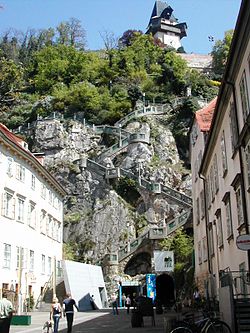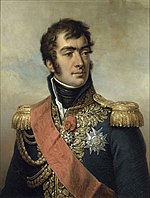Battle of Graz
The Battle of Graz took place on 24–26 June 1809 between an Austrian corps commanded by Ignaz Gyulai and a French division led by Jean-Baptiste Broussier.
Before the Battle of Raab on 14 June, the Franco-Italian army left Broussier's division in its rear to besiege an Austrian garrison in the Graz citadel.
When Gyulai's force appeared before the town in late June, Broussier retreated, allowing the Austrians to resupply the garrison.
Surrounded by a greatly superior force of Austrians, the French stubbornly defended their position until the next afternoon, then broke out of the encirclement.
Shortly afterward, Emperor Napoleon I summoned both Marmont and Broussier to march to Vienna, where both participated in the climactic Battle of Wagram on 5 and 6 July.
On 8 May 1809, the Viceroy of Italy, Eugène de Beauharnais and his Franco-Italian army defeated General der Kavallerie Archduke John of Austria at the Battle of Piave River.
This dispersal of the available Austrian military units made Eugène's subsequent invasion of Inner Austria considerably easier.
[12] On 26 May, Eugène reached Bruck an der Mur and established contact with Napoleon's main army[13] which had occupied Vienna on 13 May.
[14] MacDonald occupied Ljubljana on 23 May, capturing 7,000 muskets, 71 artillery pieces, and large supplies of food and munitions.
[15] Another French column occupied Trieste, seizing 22,000 British-supplied muskets intended for the use of the Hungarian and Croatian militia.
Ordered to move closer to Eugène, MacDonald marched northeast to Maribor (Marburg an der Drau) where he met Grouchy and a cavalry-infantry force.
At this time Ignaz Gyulai's corps lay at Zagreb (Agram) while Archduke Joseph, Palatine of Hungary collected about 10,000 Hungarian Insurrections militia at Győr (Raab).
[16] In a series of clashes in mid-May, Marmont's XI Corps fought its way north in the Dalmatian Campaign, capturing Stoichevich and mauling his command.
Covered by Eugène's army, General of Division Jacques Lauriston besieged the fortress of Győr and captured it on 23 June.
[19] At 10 pm Colonel Jean Hugues Gambin led 1,200 soldiers and two cannons into Graz's outskirts and rapidly seized 450 surprised Austrian as prisoners.
Becoming aware that he was surrounded by greatly superior forces, Gambin organized a defensive position in the walled cemetery while his voltiguer (light) companies picketed the nearby streets.
Not only Marmont, but Broussier, Eugene, and other outlying elements of the French emperor's armies were called upon to march immediately to Vienna[26] where they fought in the climactic Battle of Wagram on 5 and 6 July 1809.
[19] However, the 84th Line's epic defense pleased him and when Broussier's division arrived at Vienna, the emperor awarded 84 crosses of the Legion d'honneur to deserving officers and soldiers of the regiment.
Napoleon made Colonel Gambin a Count of the Empire and allowed the 84th Line Infantry Regiment to inscribe UN CONTRE DIX (One Against Ten) on its colors.






